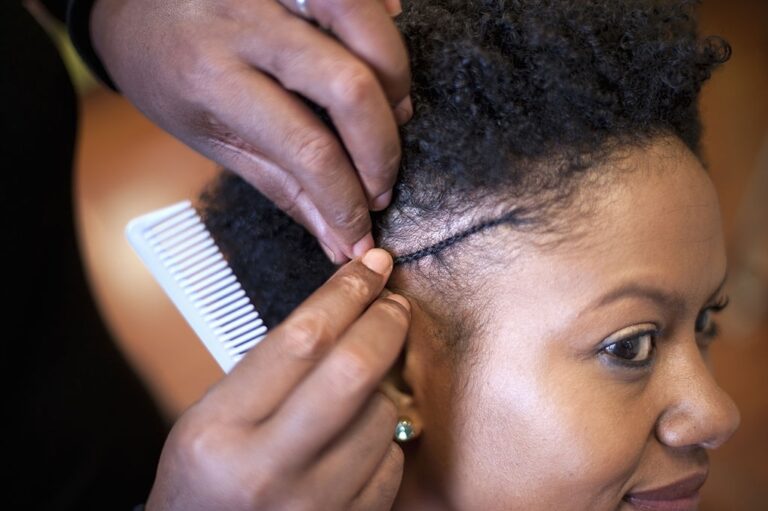A woman’s hair is usually seen as a symbol of her beauty and personality, and for eons, women have been using hair extensions (weaves) to enhance the natural beauty and uniqueness of their hair. Hair weaves have always enjoyed popularity, particularly among women of color for several reasons. However, in recent years, as more stars and celebrities began to experiment with new hairstyles, they have become even more ubiquitous.
Like hair coloring, a hair weave is a relatively easy and non-invasive way to change your appearance. But if you are considering adding a weave to your natural hair, you should probably explore your options first. You should also understand the effects that certain hairstyles can have on your natural locks, as well as the precautions that you can take to minimize the risks of damaging your natural hair and scalp. To help with this, we would like to discuss certain steps – or tips – involved when adding a weave to your hair:
Step 1: Choose a Hair Type
Before you get a weave, it is important to know the type of hair you wish to add to your own, as its color, texture, and overall appearance will determine how attractive – and realistic – the weave will look on you.
Extensions and weaves come in both synthetic and natural forms and you will want to think carefully about your lifestyle and desired to look before choosing a hair type. Synthetic (plastic) hair has its uses, particularly for braided or twisted styles. However, synthetic hair is not ideal for more free-flowing styles because it will not provide the desired natural look and will be easily detected as fake. It may also damage your natural hair and irritate your skin. Human hair is more suitable for use with free-flowing styles, and there are many types to choose from: Asian, European, and Virgin/ raw hair. Your personal preference, hair type, and cost restrictions will determine what type of extensions you and your stylist will choose.
Step 2: Choose a Hair Application Method
Once you have determined what type of hair extensions or weave you want, you will need to decide if you want to have them applied in a single strand method, or in wefts.
Individual strand methods involve taking small groups of hair, maybe 20-50 strands, and applying these sections to your own hair. The hair is attached with heat fusion, adhesive, clamping, or waxes. Most of the individual methods involve coating the natural hair with foreign substances and then applying the extensions. These styles last only a few months before they must be removed and re-applied, otherwise, you will be at risk of severe hair and scalp damage.
On the other hand, you may choose to have your extensions applied in the form of wefts. A weft is a grouping of hair that is continuously connected at the top, resembling a curtain, and free-flowing at the bottom (you may often hear people refer to wefts as tracks). Wefts come in two forms: machine-generated and handmade. As you would imagine, those that are handmade are more expensive and more natural-looking than those that are produced via machine. Machine wefts come in all shades and sizes and are cut after they are attached to your natural hair. Handmade, natural wefts are made to match your hair pattern and custom-designed to suit your individual head and scalp. Consequently, they may be attached via glues, heat fusion, or sewing.
Step 3: Choose an Attachment/Bonding Method
After you have picked a hair type and application method, you will need to decide how you want the weave attached to your own hair.
There are three basic types of weaves: braided, bonded, and fusion.
In a braided weave, your natural hair is braided along your scalp in tiny horizontal cornrows. These braids are done in the middle of your scalp and should not be noticeable once the weave is attached. The top area of the hair, known as the crown, will cover the highest braid, making it invisible. And then, your weave will be sewn onto the braids using heavy weaving thread. Your own hair is combed over the extensions so that they blend in.
The number of braid rows will be determined by the amount of hair you want to add and how your stylist thinks the weave will best simulate your own hair. A braided weave usually lasts about two months and, if proper care is taken, it can actually stimulate your own hair growth; assuming it is not too heavy and pulls your natural hair. Another advantage is the absence of any chemical or heating process, which can cause damage to your natural hair.
It is, however, important to care for this type of weave meticulously. If the braids are too tight, or if the extensions are too heavy, there is a high risk of pulling out your own hair. You must also be careful to keep the areas around the braids from drying out and becoming brittle, as this may result in hair breakage, hair damage and scalp damage. It is also advisable to apply oil to the areas of the scalp around the braids to prevent breakage and premature balding.
Bonded weaves are another popular method of applying extensions. In this process, the hair is first divided into small sections and a bonding glue adhesive is used to attach the weave to the natural hair near the scalp. The glue should be used sparingly and your stylist should avoid getting excessive amounts on your scalp.
This method can be tricky and may cause damage to your hair especially when it is removed. Another reason why you may want to be careful with this method is that some people are known to have allergic reactions to the bonding solution. Therefore, it is advisable that you first test the adhesive on a small patch of skin before having it applied to your entire head.
Bonded weaves usually last between one and two months before they start to loosen on their own. Before this happens, you should return to your stylist to have them removed by a professional. This is important if you do not want your natural hair pulled out during the removal process.
In the case of fusion weaves, however, the natural hair is divided into small sections and then the extensions are attached to the natural hair using hot wax. Weaves attached using this method tend to last longer – for about 2-3 months – and are also a bit more expensive. As with the bonded method, there are no weave tracks to hide, so the hair appears to be growing from the scalp and it appears full.
Step 4: Ongoing Care
After your weave is completed, it will be important to think of your extensions like your own hair. When done by a professional, the average hair weave – whether glued, heat-bonded, or sewn into natural hair – lasts for about two months. During this time, you will need to wash your weave as well as your natural hair.
Weaves, when installed, are especially prone to becoming brittle and dry because they are not attached to the scalp and therefore do not receive any of the body’s naturally nourishing oils. Your natural hair will also become dry and brittle if it is not washed, conditioned, and moisturized on a regular basis. Therefore, you will want to use gentle products to clean your hair. You will also want to keep your hair moisturized, using a deep conditioner.
Also, avoid over-processing the hair, like dyeing and bleaching hair with extensions will cause undue stress to your own natural hair, it will dry out your weave as well. To prevent this dryness, you must be careful when blow-drying and curling the weave. You should also avoid over-exposure to the sun and sun damage, as it can bleach your weaves and extensions; causing them to lighten or change color, and to become frizzy. UV rays from the sun may damage weaves and extensions by breaking down their bonds, thereby making them dry out and tangle easily. Their color may also fade out. The effects of sun damage are particularly dearer on natural weaves, as it usually is on natural hair. To prevent this, wear a hat in the sun and moisturize your weaves properly. If you burn the extensions, they will remain that way until they are removed, and then, if care is not taken, your own natural hair may develop split ends, or become frizzy and unmanageable.
Although you should care for your weave as if it were your own hair, do not forget that it is a foreign object that has been attached to a part of your body. Because of this, if weaves are not kept clean, they can collect bacteria. Always wash your scalp as well as your natural hair and the weave hair every 7-14 days. And after about 6- 8 weeks, you should return to your stylist and have your extensions removed. Your hair will have grown out quite a bit by then (about 1/2 inches) and the extension hair will have started getting old and dry.
If you have braids your stylist will need to undo them and check for damage to your natural hair. If the natural hair and your hairline have remained healthy, you will just need to have your old extensions removed and new ones added. If the natural hair is in need of repair, give your hair at least a 6-month rest from the weaves and see your dermatologist.
In conclusion, weaves and hair extensions are a great way to enhance naturally beautiful hair. As a woman of color, weaves provide a way for you to experiment with new styles and current hair trends in a unique way. However, they can also cause hair and scalp damage.
Many women do not realize that while the length can be beautiful, long heavy extensions will also put additional pressure on the scalp. This pressure may cause long-term hair damage in the form of thinning and pre-mature balding. Therefore, if you are trying to grow your hair long by using weaves and hair extensions for protective styles, you should consider the potential hindrances that this could pose to your long-hair quest. But if you simply wish to have a new look for a few months, and you are prepared to possibly lose some of your natural hair along with the extensions, then, no problem.
Finally, is important to visit a professional before you have extensions applied. Weaves provide new looks which are usually easily cared for, but you must be aware that these procedures have a limited life cycle. It is important to take care of your hair during this time and to do proper upkeep while you experiment with your new look.



